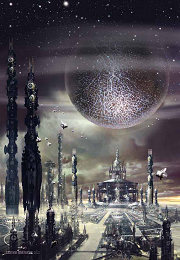 My copy's cover carries this blurb:
My copy's cover carries this blurb:
“In the tradition of Isaac Asimov's Foundation series and Frank Herbert's Dune books.”
--The New York Times
This book is in the tradition of Foundation and Dune in the same way Snow Crash is in the tradition of Beverly Cleary's "Beezus and Ramona" series, which is to say NOT.
The Risen Empire has a couple of things going for it. It has some fast-paced high-tech tactical combat. The action is quite brutal and bloody, actually. The kind of thing that might appeal to gamers—console first-person shooters, like Halo and Call of Duty, primarily. I suppose.
The book is also just chock-full of spiffy far-future technology ideas. It's a cornucopia of hyper-advanced weaponry, amazing vehicles, futuristic medical systems, wondrous communications devices, meta-intelligent machines, etc. The prose is so richly saturated with exposition of the author's prodigious technophilia that it sometimes gets in the way of the story.
For example, there are extended passages about a Von Neumann machine-like house that builds itself in the polar region of a planet. Written, more-or-less, from the point of view of the house's AI, this is not in itself an uninteresting idea. But it's about as welcome as a commercial interruption in the middle of a free-throw attempt where the author presents it. White-hot battle scenes, fulminating political intrigue, compelling foreshadows of mysterious secrets . . . and then BAM: “Hello snowy mountainside and happy sentient house construction.” All it lacks is a catchy jingle.
Indeed, fragmented storytelling is The Risen Empire's biggest problem. Westerfeld structures the book as a sequence of short narratives, each told from a different character's (house included) point of view. This amounts to waaaay too much viewpoint shifting. From the reader's all-important viewpoint, the story does not flow comfortably. And this uncomfortableness, sadly, is entirely intentional.
Westerfeld's narrative strategy also fails to overcome the challenge of getting the reader invested in his characters. Fully half of the first dozen characters whose viewpoints are introduced in the story are dead in the first eighty pages. Really dead, dead-and-gone--not just dead-and-back-again like numerous other characters. I have a rule: Don't invite me to care all that much about them if you're not going to keep them around. My time is important and I don't like to waste it.
I'm going to remain neutral on The Risen Empire recommendation-wise. I've shared some complaints but you might like the furious action, the political intrigue, or the splashy techno-wonderment.
As for what the New York Times reviewer saw in The Risen Empire that is “in the tradition of” Asimov and Herbert? Well, perhaps she meant that this work implies a sequel, and likely a multitude of sequels, the incrementally diminished quality of which will undermine the cumulative reputation of the work as a whole. This interpretation also puts it squarely in the tradition of Star Wars. But most certainly not that of "Beezus and Ramona."
The Risen Empire by Scott Westerfeld (Succession #1)
Originally posted 20 Nov 2012 on Google+